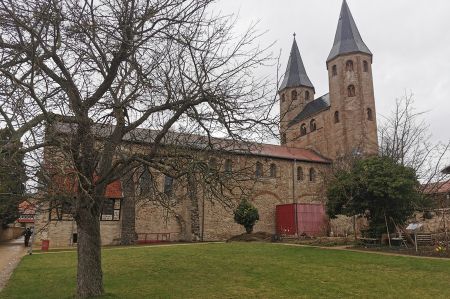Stopover at Drübeck monastery - with a recommendable café
- Written by Portal Editor
It was once again an intuitive stopover following a sign that brought us to the former Benedictine abbey, Kloster Drübeck, in the district of Drübeck near Ilsenburg on the northern edge of the Harz Mountains in Saxony-Anhalt.
And to get straight to the point, there is also a delightfully decorated abbey café which invites you to end an interesting tour of the abbey, church and gardens, well attended and delicious cakes.
Drübeck Monastery – more than a thousand years of history
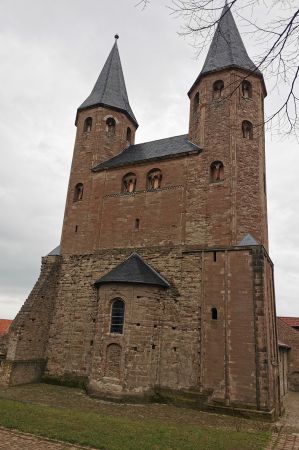 The nunnery Drübeck was first mentioned in a document of King Otto I of September 10, 960 as Drubechi. On September 8, 980, Otto II confirmed the free election of abbesses and thus the special legal status of the monastery in his royal court in Bodfeld. Thus, as early as the 10th century, the monastery enjoyed privileges such as the imperial abbeys in Gandersheim and Quedlinburg.
The nunnery Drübeck was first mentioned in a document of King Otto I of September 10, 960 as Drubechi. On September 8, 980, Otto II confirmed the free election of abbesses and thus the special legal status of the monastery in his royal court in Bodfeld. Thus, as early as the 10th century, the monastery enjoyed privileges such as the imperial abbeys in Gandersheim and Quedlinburg.
The earliest information about the construction of the church dates from August 1, 1004. A document issued by Henry II states that a new building or an extensive renovation took place. The result was the flat-roofed Basilica of St. Vitus with three double bays and a simple change of supports in the nave. The nave walls, five columns with Ottonian capitals and the south arm of the transept of this building are probably still preserved today.
Extensive renovations took place in the 12th century, the imposing west wing with the two towers was built, the church was vaulted and the staggered choir complex was added. In the Peasants' War there was heavy destruction, in 1599 a fire was even set by a gang of robbers whose leader was never caught. Repaired in a makeshift manner, alterations were made in the Baroque period.
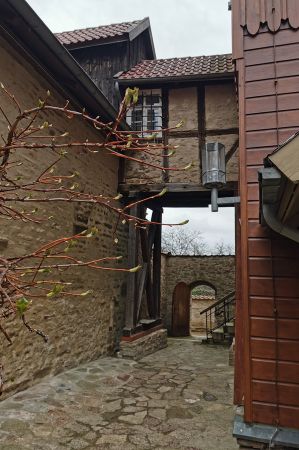 During the turmoil of the Reformation and the Peasants' War, monastery life came to an end for a short time. In 1687 the monastery buildings were transferred to the Counts of Stolberg-Wernigerode, who established a Protestant women's monastery here at the same time. In 1946, at the request of the last abbess, Magdalena, the Protestant church province of Saxony took over the Drübeck monastery as a convalescent home and conference venue. The last gun died on January 29, 1976 at the age of 88. Since 1996, the Pedagogical-Theological Institute, the Pastoral College and the House of Silence have been located in the Drübeck monastery.
During the turmoil of the Reformation and the Peasants' War, monastery life came to an end for a short time. In 1687 the monastery buildings were transferred to the Counts of Stolberg-Wernigerode, who established a Protestant women's monastery here at the same time. In 1946, at the request of the last abbess, Magdalena, the Protestant church province of Saxony took over the Drübeck monastery as a convalescent home and conference venue. The last gun died on January 29, 1976 at the age of 88. Since 1996, the Pedagogical-Theological Institute, the Pastoral College and the House of Silence have been located in the Drübeck monastery.
Today it is a conference centre of the Evangelical Church in Central Germany with a pedagogical-theological institute, a house of silence, a pastoral college and a media centre.
Gardens and 300-year-old monastery linden tree
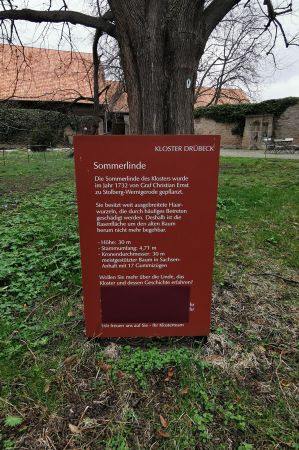 The monastery gardens are part of the tourism project "Garden Dreams - Historical Parks in Saxony-Anhalt". Today's outdoor facilities were designed based on a plan drawn by J. A. Dieckmann in 1737.
The monastery gardens are part of the tourism project "Garden Dreams - Historical Parks in Saxony-Anhalt". Today's outdoor facilities were designed based on a plan drawn by J. A. Dieckmann in 1737.
After the ownership was taken over by the Counts of Stolberg-Wernigerode, the courtyard and gardens were redesigned. In this context, the gardens of the canonesses with the prayer houses and the garden of the abbess were laid out, which are also part of today's garden landscape.
Also in this context, a summer linden was planted in the monastery courtyard around 1730. This almost 300-year-old "monastery lime tree" is now one of the natural monuments in the Harz district. Its trunk has a circumference of 5.56 meters.
Valuable bell and presumed tombstone of Abbess Adelbrin
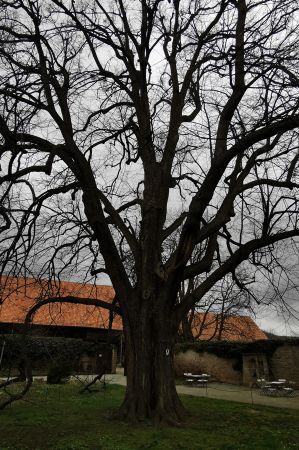 Adelbrin († around 900) was the legendary first abbess of the monastery. The non-contemporary funerary monument is kept in the crypt of the church, which is accessible from the outside.
Adelbrin († around 900) was the legendary first abbess of the monastery. The non-contemporary funerary monument is kept in the crypt of the church, which is accessible from the outside.
It is a figure grave slab made of sandstone leaning against the wall, the narrow side of which leans against a simple floor slab.
Adelbrin is considered a legendary monastery founder and saint. She is said to have been the sister of the two legendary monastery founders Theti and Wikker and the first abbess of the convent.
The three-part altarpiece, a late Gothic carving, shows the coronation of Mary by Christ in half-reliefs, flanked by male and female saints. The extremely valuable bell is the work of an unknown master and was created in 1449.
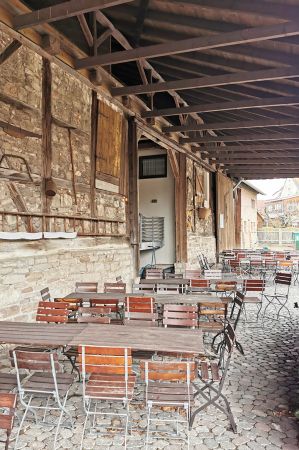 In the 1950s, attempts were made to partially peel out the original building, and half of the crypt was uncovered again.
In the 1950s, attempts were made to partially peel out the original building, and half of the crypt was uncovered again.
The buildings of the monastery are part of the Romanesque Road, a holiday route in Saxony-Anhalt.
More recently, new excavations have been carried out which, in addition to the north aisle, which was lost around 1660, have uncovered an angular foundation line in the transept area. This could have belonged to a predecessor.
Harz monastery hiking trail
Drübeck Monastery is a station on the Harz Monastery Hiking Trail. On the Harzer Klosterwanderweg, the recreational potential for body, mind and soul is excellently combined with cultural enjoyment at its finest.
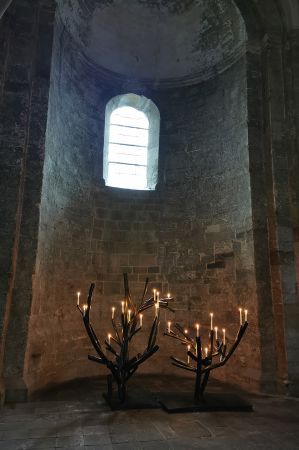 As if on a string of pearls and in an unusual density, hikers and pilgrims can explore a diverse monastery and church landscape between the two World Heritage cities of Goslar and Quedlinburg over a distance of approx. 95 km. The monastery hiking trail connects important facilities of the "Romanesque Road" and the "Garden Dreams of Saxony-Anhalt".
As if on a string of pearls and in an unusual density, hikers and pilgrims can explore a diverse monastery and church landscape between the two World Heritage cities of Goslar and Quedlinburg over a distance of approx. 95 km. The monastery hiking trail connects important facilities of the "Romanesque Road" and the "Garden Dreams of Saxony-Anhalt".
For centuries, the Harz monasteries have shaped the cultural and economic development of the Harz. With six stages between 10 and 20 km and without major differences in altitude, hikers immerse themselves in the world of fragrant monastery gardens, Gothic cloisters and fascinating churches, experience monasteries as event locations, museums and distilleries, as special places of spirituality and as good hosts. What we can only confirm after visiting the monastery café. On the way, hikers keep an eye on the Brocken, the Harz church spiers and the gentle hills of the northern Harz foothills.
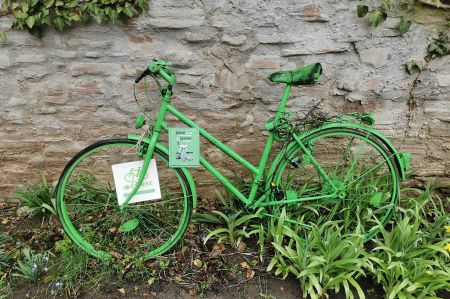 The river landscapes on the Oker, Ecker and Bode are particularly romantic, while the Teufelsmauer near Blankenburg and Thale are magnificent. You will experience the enchanting shimmering forest, hike along the former inner-German border, past monastery ponds teeming with fish and gems of Romanesque church art.
The river landscapes on the Oker, Ecker and Bode are particularly romantic, while the Teufelsmauer near Blankenburg and Thale are magnificent. You will experience the enchanting shimmering forest, hike along the former inner-German border, past monastery ponds teeming with fish and gems of Romanesque church art.
If you prefer to do the tours by e-bike, you will also find a charging station in the Drübeck monastery.
Please read as well:
St. Sophia Church (Crkva Sveta Sofija) in the center of Ohrid
Porta Caesarea - a city gate of Salona
-
 Drübeck Monastery near Ilsenburg
Drübeck Monastery near Ilsenburg
Drübeck Monastery near Ilsenburg
Drübeck Monastery near Ilsenburg
-
 Drübeck Monastery near Ilsenburg
Drübeck Monastery near Ilsenburg
Drübeck Monastery near Ilsenburg
Drübeck Monastery near Ilsenburg
-
 Drübeck Monastery near Ilsenburg
Drübeck Monastery near Ilsenburg
Drübeck Monastery near Ilsenburg
Drübeck Monastery near Ilsenburg
-
 Drübeck Monastery near Ilsenburg
Drübeck Monastery near Ilsenburg
Drübeck Monastery near Ilsenburg
Drübeck Monastery near Ilsenburg
-
 Drübeck Monastery near Ilsenburg
Drübeck Monastery near Ilsenburg
Drübeck Monastery near Ilsenburg
Drübeck Monastery near Ilsenburg
-
 Drübeck Monastery near Ilsenburg
Drübeck Monastery near Ilsenburg
Drübeck Monastery near Ilsenburg
Drübeck Monastery near Ilsenburg
-
 Drübeck Monastery near Ilsenburg
Drübeck Monastery near Ilsenburg
Drübeck Monastery near Ilsenburg
Drübeck Monastery near Ilsenburg
-
 Drübeck Monastery near Ilsenburg
Drübeck Monastery near Ilsenburg
Drübeck Monastery near Ilsenburg
Drübeck Monastery near Ilsenburg
-
 Drübeck Monastery near Ilsenburg
Drübeck Monastery near Ilsenburg
Drübeck Monastery near Ilsenburg
Drübeck Monastery near Ilsenburg
-
 Drübeck Monastery near Ilsenburg
Drübeck Monastery near Ilsenburg
Drübeck Monastery near Ilsenburg
Drübeck Monastery near Ilsenburg
-
 Drübeck Monastery near Ilsenburg
Drübeck Monastery near Ilsenburg
Drübeck Monastery near Ilsenburg
Drübeck Monastery near Ilsenburg
-
 Drübeck Monastery near Ilsenburg
Drübeck Monastery near Ilsenburg
Drübeck Monastery near Ilsenburg
Drübeck Monastery near Ilsenburg
-
 Drübeck Monastery near Ilsenburg
Drübeck Monastery near Ilsenburg
Drübeck Monastery near Ilsenburg
Drübeck Monastery near Ilsenburg
-
 Drübeck Monastery near Ilsenburg
Drübeck Monastery near Ilsenburg
Drübeck Monastery near Ilsenburg
Drübeck Monastery near Ilsenburg
-
 Drübeck Monastery near Ilsenburg
Drübeck Monastery near Ilsenburg
Drübeck Monastery near Ilsenburg
Drübeck Monastery near Ilsenburg
https://www.alaturka.info/en/germany/saxony-anhalt/6028-stopover-at-druebeck-monastery-with-a-recommendable-cafe#sigProIdaf7378288f
